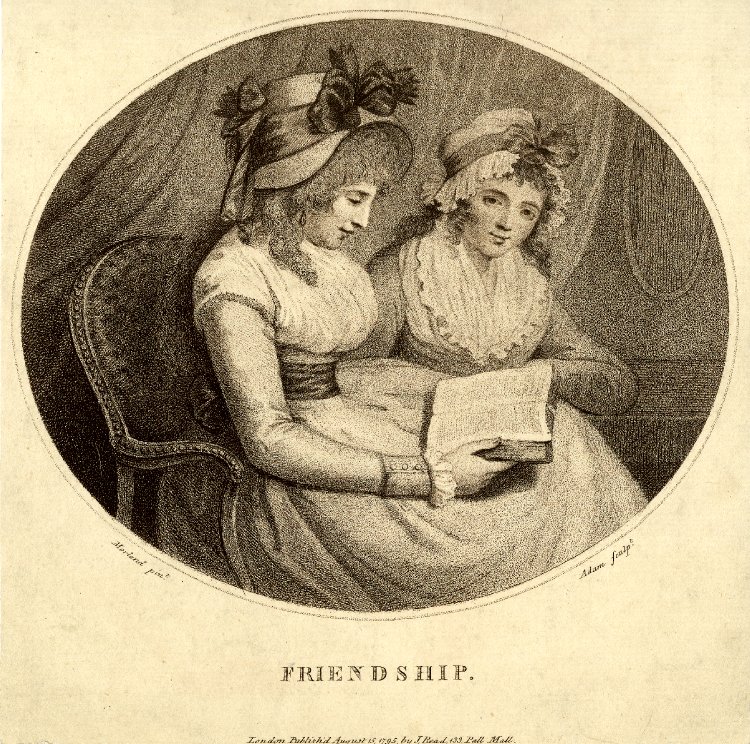
 Professor Mark Knights of the University of Warwick and Dr Tessa Whitehouse of Queen Mary, University of London are the convenors of a project exploring the meaning and history of friendship. In this blog post they explain their research findings and future plans.
Professor Mark Knights of the University of Warwick and Dr Tessa Whitehouse of Queen Mary, University of London are the convenors of a project exploring the meaning and history of friendship. In this blog post they explain their research findings and future plans.
__________
“The Mind never unbends it self so agreeably as in the Conversation of a well chosen Friend”
(Addison, Spectator 93, 16 June 1711)
How can we study a subject such as friendship — something so familiar, with such loose boundaries and touching on almost every aspect of life? That question lay at the heart of two workshops held in 2013 at the universities of Warwick and Queen Mary, before the BBC Radio 4 series ‘Five Hundred Years of Friendship’ was conceived. In them, a group of scholars from across the humanities explored friendship in theory and practice, focusing on the eighteenth century.
Friendship, we found, came in many guises, and the word ‘friendship’ was used to define a multiplicity of relationships. Our discussions first sought to categorise the multiple varieties of friendship that were recorded in a century often characterised by sociability. We talked about literary, political, religious, scientific, economic, transnational friendships and also thought about enmity, for we found that looking at the opposite of the thing in which you are interested can shed light on it. After all, friendships can go badly wrong, creating dramatic breaches and enduring hostilities. The more we talked, the more we realised that the ‘rules’ and boundaries of friendship were often uncertain and shifting. That made it even more important to try to find suitable ways of approaching the topic. So here are the four themes that we think might be useful ways forward:
1. Time. It would make sense to study friendship from the Renaissance to the end of the eighteenth century in order to chart certain key shifts and developments as well as enduring characteristics. This would enable us to explore intellectual friendships between humanist scholars in the Renaissance as well as the ‘republic of letters’ that characterised the seventeenth and eighteenth centuries. Taking ‘early modernity’ as our focus would also highlight the way in which Reformation religious teachings influenced ideas about friendship, imbuing it with godly piety, and chart how more secular and commercialised forms of friendship were also fostered in the eighteenth century. But thinking about ‘early modernity’ also raises interesting questions about continuities, both within the period and either side, from the medieval period and into the Victorian.
2. Space. Intellectual, scientific and commercial friendships often expanded beyond national boundaries; sometimes groups of friends found themselves in voluntary or forced exile, as a result of war or state repression, or separated by the expansion of Britain’s overseas empire. Even within a country, different spaces facilitated friendship in different ways: clubs, coffee houses, alehouses, assembly rooms, bookshops, market places, leisure resorts, churches and new urban spaces all enabled friendships but also shaped how they worked. Different customs or necessities in colonial contexts could also shape how friendships formed and operated. One way of thinking about space is with the help of network analysis: examining how networks of friends were created and who were key ‘nodes’ in these networks, linchpins around whom they revolved. Some friendships within these networks were stronger or weaker than others; and some were advanced or hindered by geography.
3. Text. Not all friendship operated in a face-to-face manner. Indeed, many of the networks of friends operated with the aid of letters or print. Both media boomed in the early modern period in new and interesting ways. Improvements in transport and infrastructure, as well as in the cost of paper and the rise of literacy rates, meant that letter-writing became easier, cheaper and more widespread. Similarly the development of print in the late fifteenth century and its proliferation from the mid seventeenth century onwards enabled people not only to publish books, pamphlets and periodicals that discussed friendship and offered advice about how to conduct it, but also meant that friends could interact in different ways, singing a printed ballad together, for example, or creating ‘print communities’ that gathered and even created groups of friends with shared interests. Moreover, those texts – whether printed or manuscript – can help us understand the practice of friendship: the collecting of letters, or the speed of response, or the style in which something was written can tell us about the nature of the friendship.
4. Object. Letters and print about or from friends were precious objects, saved in family, state and commercial archives. But objects are also important in other ways. The exchange of gifts between friends was one way of strengthening friendship, but there was an art to this: a present had to be carefully judged and the giver had to avoid the excessive and corrupt on the one hand, and the inadequate and insulting on the other. Objects were also specially created to be exchanged between friends. Sometimes these were works of art, such as portraits, that could in turn also depict friendship or provide talking points about friendship. There is thus a material culture associated with friendship. Some of that was ephemeral (the elaborate dinner cooked for friends has been consumed long ago) but some of it survives – thetableware associated with such entertainments, pictures, sculptures, architecture and other material traces. Collaboration with archives, galleries and museums would help us to recover this important but often neglected aspect of friendship.
Our group plans to widen our discussions in the near future to include scholars working in institutions beyond ours who share interest in the themes outlined. We also intend to engage with the wider public through a website. It is worth remembering that our word ‘social’ comes from the Latin word for friend, ‘socius’, so social media seems a particularly appropriate way of creating a network of friends talking sociably about friendship! If you would like to be put on our mailing list please register you details here.
__________
Register your interest in the Warwick-Queen Mary Friendship Project
Return to: Five Hundred Years of Friendship at the History of Emotions Blog


